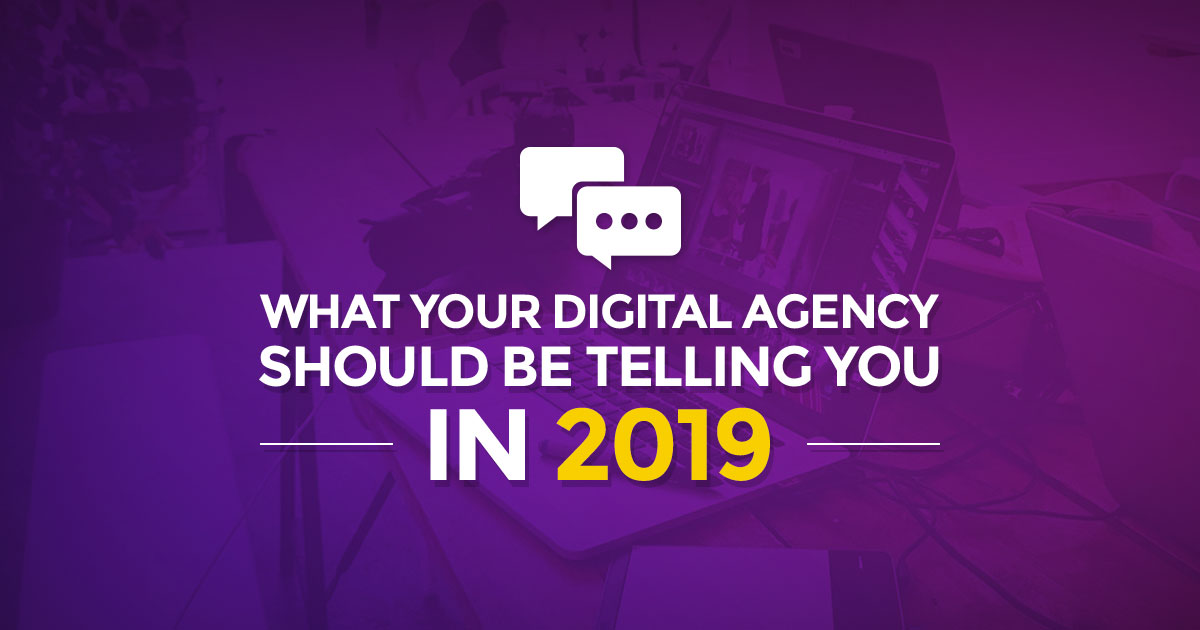Between mid-December and early January, almost every agency and marketing expert will have published some form of “predictions for the new year” blog or column (for the purposes of full disclosure, here was our effort).
But what many of these blogs tend to do is fall into the trap of future-gazing about concepts, ideas and technologies that have little if any relevance to the day-to-day marketing challenges that we face in 2019. Many of us will have no need nor application for artificial intelligence or virtual reality in the coming year. Instead, the sort of things that will be front of our minds will be a combination of the usual challenges that we’re still grappling with – how we actually attribute our efforts and prove our value for example, along with the new ones that Google, competitors and consumers have thrown our way in the form of EAT updates and market disruption.
So what should your agency really be telling you in 2019? Here are six topics of conversation that we believe are the most pertinent to your digital strategy.
Breaking down the silos of SEO and paid search for a more joined-up search strategy

One of the first things that your agency should be talking to you about is how to better integrate your paid search with your organic search. Whilst this may not necessarily be relevant for every brand, it is particularly important that those brands that are deploying both paid search and SEO strategies think much more carefully about how they approach these channels and tactics – because it can lead to significantly improved return on investment.
One of the things that we are increasingly discussing with the brands and clients that this applies to is how the old rules of paid search and organic search are becoming less and less relevant. Consumers and online audiences aren’t channel-specific, so it makes little sense for marketing strategy to focus on different channels in silo.
Instead, we believe that brands and agencies should be communicating with each other much more than they currently are, with the intention of creating much more data-led, cohesive and mature approaches to both organic and paid search marketing.
The focus for you as a brand marketer should be on getting both organic and paid to complement each other, encouraging better lines of communication between your agencies and getting your agencies working in a way that is more beneficial for you, rather than working in a way that’s beneficial for them.
It requires a step-change in thinking. It’s a model that requires both you and your agencies to come up with new ways of reporting, it requires a new model for incentivisation and it means creating a culture that focuses on collaboration and communication. But these changes are ultimately going to pay dividends if it results in much more efficient use of your marketing budget – and isn’t that what we all want?
How your digital strategy needs to reflect the rise of e-retail and online marketplaces

Amazon and its competitor marketplaces have shaken-up product search. Forever.
Searching for products on ‘one-stop’ environments such as Amazon has become second nature to an increasing number of consumers – around 51% of product searches now start on Amazon, according to the Salmon Future Shopper Report.
That trend is only going to grow. Amazon has spent recent years developing a series of products and services that are effectively ‘locking in’ more and more consumers, such as its Prime membership scheme, video content and its connected devices such as Echo, Alexa and Kindle. For those consumers who have bought into those concepts, it makes it a much harder decision for them to go back to the traditional route of finding products on Google.
Many retailers and FMCGs will naturally be reluctant to start trading with what is, to all intents and purposes, still a competitor. There are good reasons for many not to jump onto marketplaces with both feet just yet, but it is also important for them to realise that in order to generate traffic, you need to go where that traffic actually is.
This phenomenon isn’t entirely new. We have seen similar developments in sectors such as travel and financial services, where comparison websites have emerged in a relatively short space of time to dominate the search traffic and effectively become the ‘default option’ for consumers in those markets. Brands such as Amazon (and similar marketplaces in different markets) are simply performing that same function in the retail space but as that trend grows, ecommerce brands need to start working with their agencies to adapt their strategies to that reality.
Be there for the whole journey – not just for the last click

Google’s ‘micro-moment’s concept is not something that is particularly new. It has been with us since 2015, but it is probably fair to say that there are still many brands that haven’t really embraced the ideals behind the model.
Many of those brands that are focusing predominantly on those buying ‘micro moments’ will most likely be doing so because they are working on a ‘last click’ attribution model. It’s a model that is something of a self-fulfilling prophesy and will naturally guide them to create commercial content, and neglect more informational content, because it shows that the commercial content works.
But this flawed approach could mean that these brands are potentially missing opportunities to engage with audiences, build positive sentiment and to attract traffic across the long-term.
You need to make better use of Google’s improved attribution tools, along with your own CRM and analytics tools, to understand the value of content marketing across the whole customer journey, not just the last click.
EAT isn’t just about content, it’s also about proposition

There has been a lot written about the Google EAT update, but one thing that is clear is that this is an update that goes far beyond the concept of content and search marketing. This is actually an update that touches so many elements of a brand and its business operations.
EAT isn’t just about whether consumers can trust and believe your content; its about whether they can trust and believe your brand. It’s not about whether the words on your website are credible and that they make sense; it’s about whether a consumer can trust that their order will turn up on time, and that you will do the right thing if they have a problem.
Many marketers and agencies have responded to the EAT update by focusing on the pure search implications and in many respects that is what they should be doing. However, even stripping your content away and starting again with an army of experts is not going to make a material difference if the fundamental issue is that your brand is not as trusted as your competitors are.
Think about how EAT-ready your business is. What do your reviews say about you, is your brand proposition open, honest and caring? Why should an audience buy from you? This is really what EAT is all about.
Build your strategy around audience intent

We are now at a point were two people searching for the exact same keyword can receive very different results, and intent is at the heart of this.
In many respects, it’s hard to quantify a “position one” any more, as what is “position one” to one searcher is very different to that of another.
But what we can do as brands and agencies is start to better understand that intent, and to better understand how we engage with our audiences throughout the funnel. It comes down to thinking about how we serve differing needs at different stages and, in some respects, how we protect our brands during times of crisis – negative media coverage or a consumer and social media backlash.
Don’t just understand the ‘what’ behind a search, understand the ‘why’. When you do that, creating the right content and being active in the right places becomes so much easier.
The technical foundations still matter

So much of what we have seen about search and about Google in recent times has been about the more creative and subjective sides of search, and there is nothing wrong with that.
But the foundations of a sound search strategy cannot be built on sand and it can be easy to forget that for all of the focus on EAT, relevance and content, good technical proficiency remains the building blocks of what we do as search marketers and of search agencies.
The standard is only going to keep going upwards when it comes to what Google expects us to deliver to audiences, and the technical foundations and architecture to deliver that will remain as important as ever.
What is your agency telling you in 2019?

In the fourth edition of our annual guide we take you through the key developments in search and ecommerce, including key Google algorithm updates and changing trends in consumer behaviour – and explain how you need to respond.
If you’re responsible for developing and implementing your brands online strategy or for managing agency relationships then this 50-page guide is not to be missed.
Download this easy-to-read guide and discover:
- What you need to do to ensure your brand remains visible online
- How you can use paid and organic search together to get more out of your budget, resources and agencies
- How your strategy needs to change if you work in e-commerce or e-retail
- The importance of search intent and how you can make sure your brand is visible throughout the entire customer journey
- Why technical foundations still matter
Download the report by filling in the form now.
